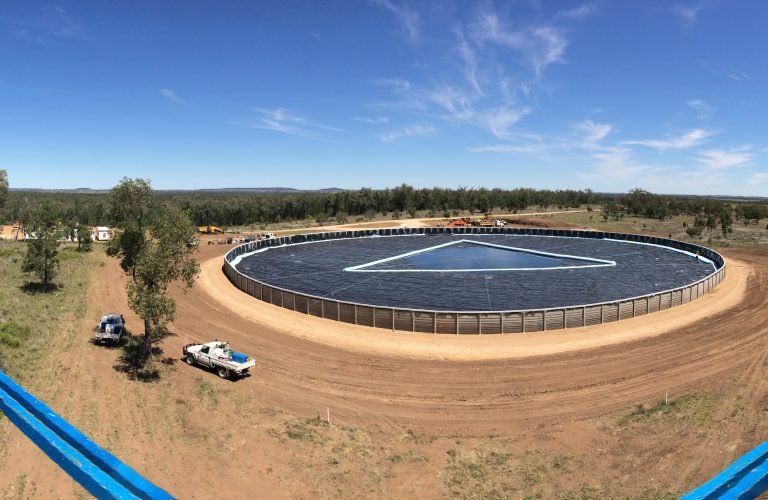Background Information and Challenge
Increasing oil and gas supply from unconventional reserves has reduced oil prices. This has scrutinized the costs of exploration and bringing new facilities into production. Oil and Gas companies outsource these activities to highly efficient specialist contractors to reduce costs. Water storage for large volumes of water can add significantly to the regulatory, financial and construction liabilities of developing new sites.
This project was located at a remote site, and the client had established a highly efficient development process that reduced project costs by up to 60 percent. To achieve the outcome at a low-cost, saline water storage servicing several satellites was required.
Solution
The contractor, Concept Environmental Services, designed a unique above-ground water storage tank with the minimal environmental impact on the site. The 110m diameter by 2.5m high tank utilizes pre-cast concrete wall panels interlocked into steel columns with the entire structure pre-stressed with tensioned cables.
Layfield’s Enviro Liner® 6030 geomembrane was selected for the double lining of the 25 million litre tank due to the material’s excellent UV, weathering and chemical resistance and flexibility. A leak detection layer and monitoring system were incorporated into the design to guarantee no discharge to the environment in case of a breach or damage to the primary liner. A unique ballasting system was developed to keep the double liner system in place when the tank was dry.
Installation
A specialist lining sub-contractor pre-fabricated the Enviro Liner® 6030 into large panels in a controlled, clean factory in preparation for rapid on-site deployment. All tank components and the pre-fabricated liner panels were transported to the site. After simple site preparation (grubbing, levelling and compaction of natural ground), the contractor installed the tank structure. The lining sub-contractor then installed the large pre-fabricated panels in a pre-determined sequence, completing and testing the secondary liner before installing the leak detection layer.
The primary liner was installed in the same manner as the secondary liner. The liner system was secured to the top perimeter of the tank, and a ballast system was installed to keep the liners in place while the tank was empty.
Results
The entire tank installation only took two weeks, and the client was extremely happy with the result. The rapid installation reduced the probability of weather-related risks and also resulted in a significant reduction of costs associated with remote site accommodation. The construction and installation time was less than half that of comparable storage solutions for the capacity required. The installation also proved the capability of very large-diameter storage tanks.

